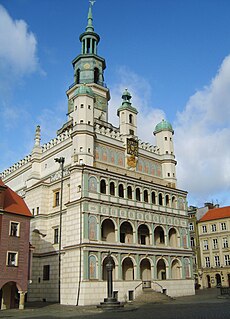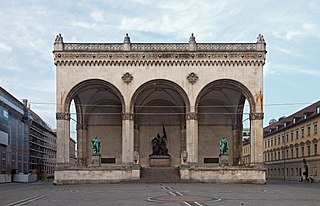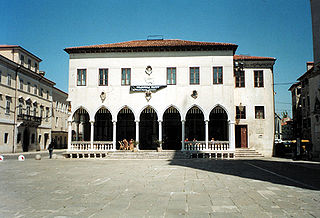 W
WA loggia is an architectural feature which is a covered exterior gallery or corridor usually on an upper level, or sometimes ground level. The outer wall is open to the elements, usually supported by a series of columns or arches. They can be on principal fronts and/or sides of a building and are not meant for entrance but as an outdoor sitting room. An overhanged loggia may be supported by a baldresca.
 W
WThe City Hall is a historical building in Cologne, western Germany. It is located off Hohe Straße in the district of Innenstadt, and set between the two squares of Rathausplatz and Alter Markt. It houses part of the city government, including the city council and offices of the Lord Mayor. It is Germany's oldest city hall with a documented history spanning some 900 years. The history of its council during the 11th century is a prominent example for self-gained municipal autonomy of Medieval cities.
 W
WThe Feldherrnhalle is a monumental loggia on the Odeonsplatz in Munich, Germany. Modelled after the Loggia dei Lanzi in Florence, it was commissioned in 1841 by King Ludwig I of Bavaria to honour the tradition of the Bavarian Army.
 W
WThe Loggia Palace is a Venetian Gothic palace in Koper, a port town in southwestern Slovenia. It is the only preserved Gothic town hall in Slovenia.
 W
WThe Moses Goldsmith Building is a historic residence in Cincinnati, Ohio, United States. Built in 1900, it was originally owned by Moses Goldsmith, the president of a firm that sold notions; rather than living in the house, Goldsmith built it for investment purposes, renting it to others.
 W
WPinto's Loggia or Pinto's Lodge, is a loggia in Qormi, Malta. It was built in 1772 to commemorate the 31st year of Manuel Pinto da Fonseca's magistracy, and it is now a landmark and symbol of Qormi.
 W
WThe Vatican loggias are a corridor space in the Apostolic Palace, originally open to the elements on one side, which were decorated in fresco around 1519 by Raphael's large team of artists, with Giovanni da Udine the main hand involved. Because of the relative unimportance of the space, and a desire to copy the recently re-discovered Domus Aurea style of Ancient Roman painting, no large paintings were used, and the surfaces were mostly covered with grotesque designs on a white background, with paintings imitating sculptures in niches, and small figurative subjects in a revival of Ancient Roman style. This large array provided a repertoire of elements that were the basis for later artists creating grotesque decoration across Europe.